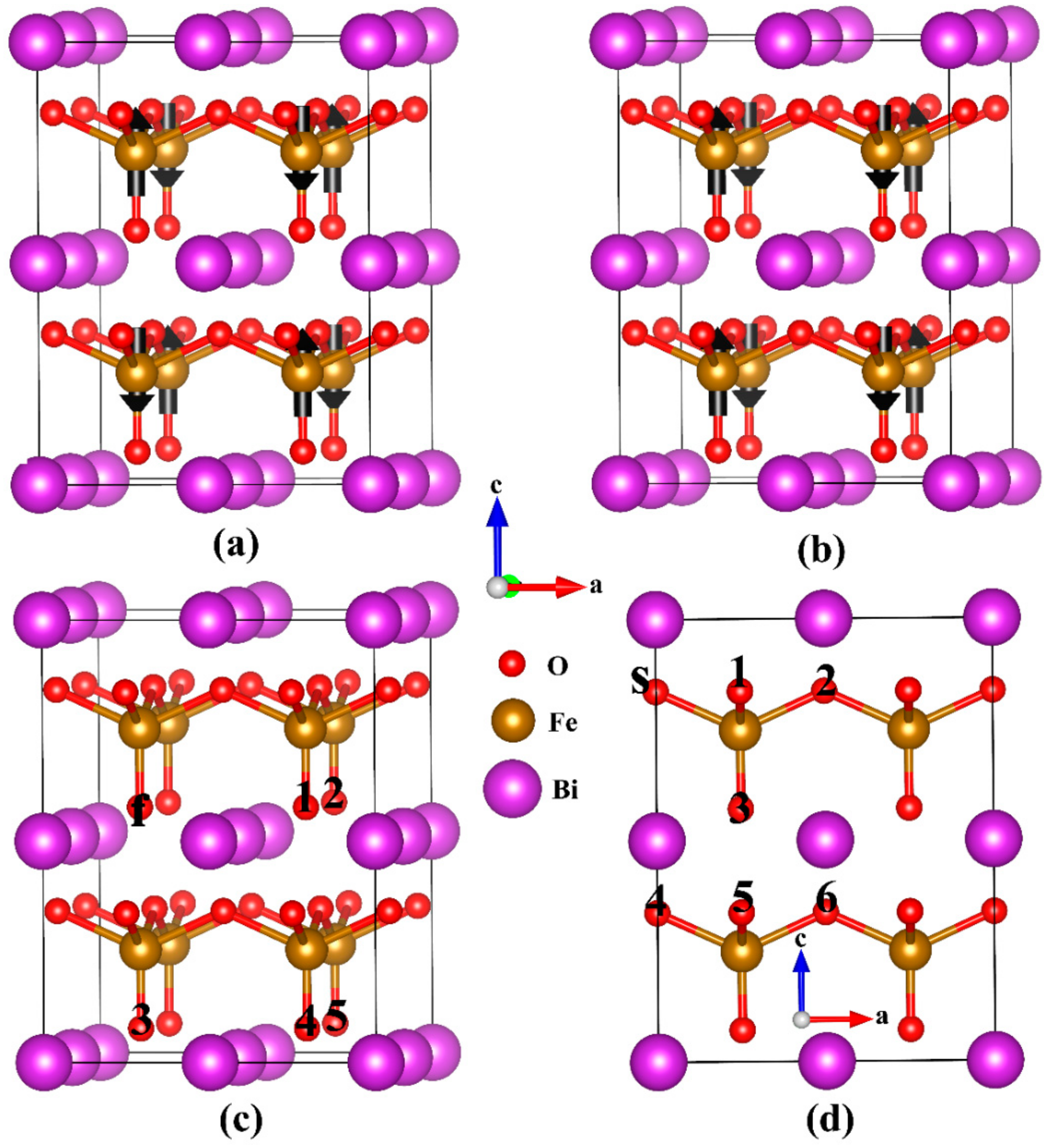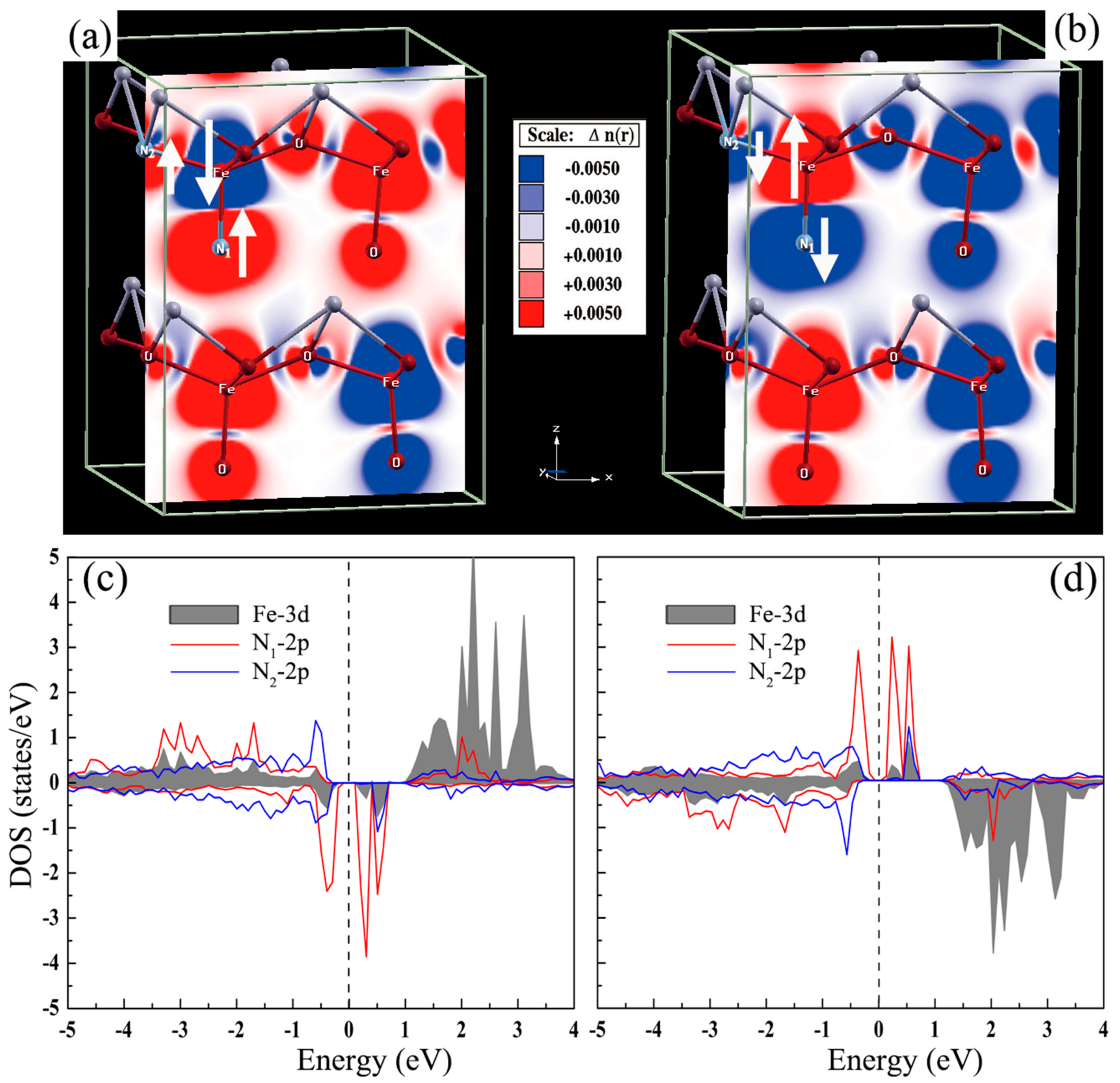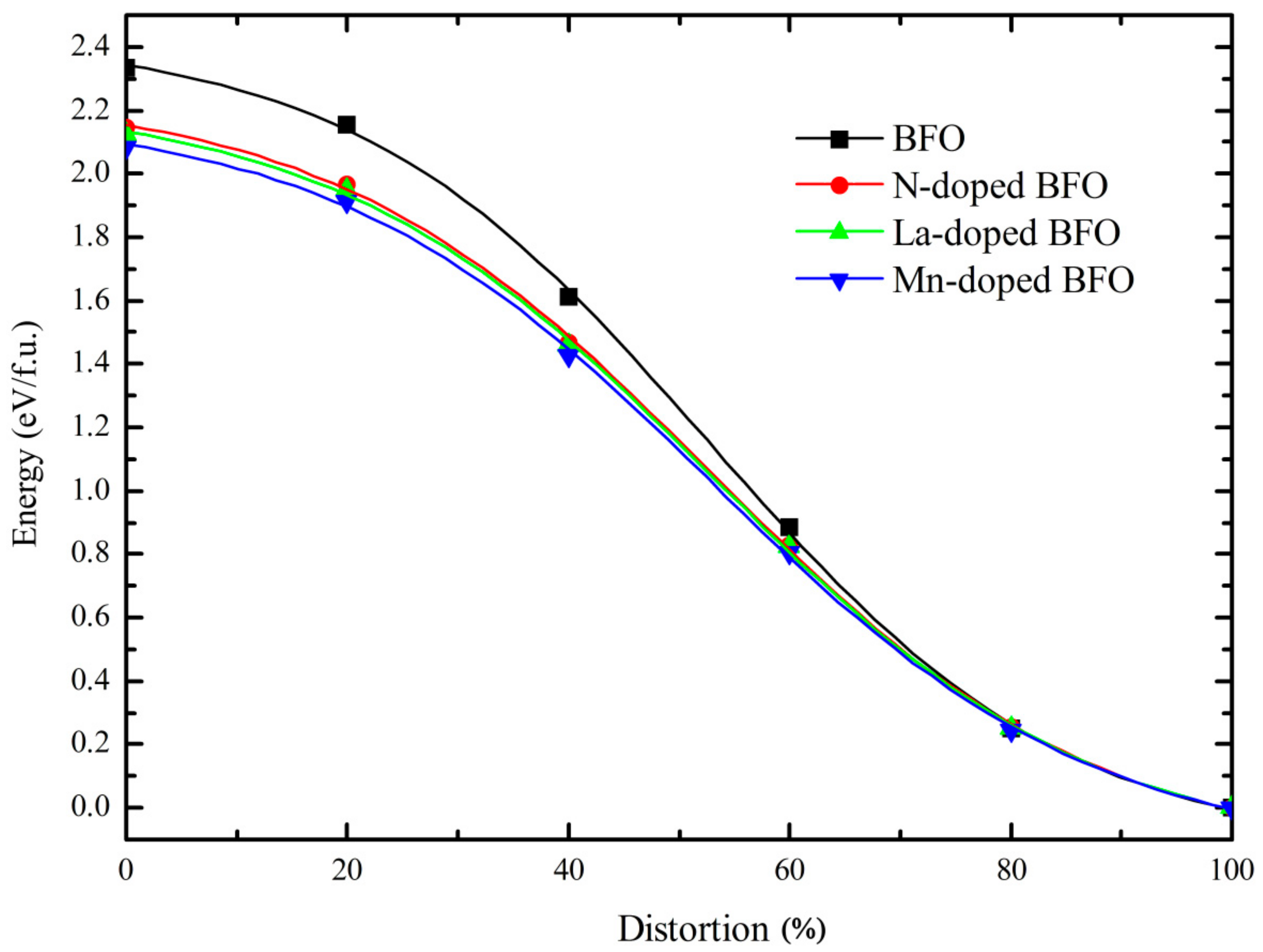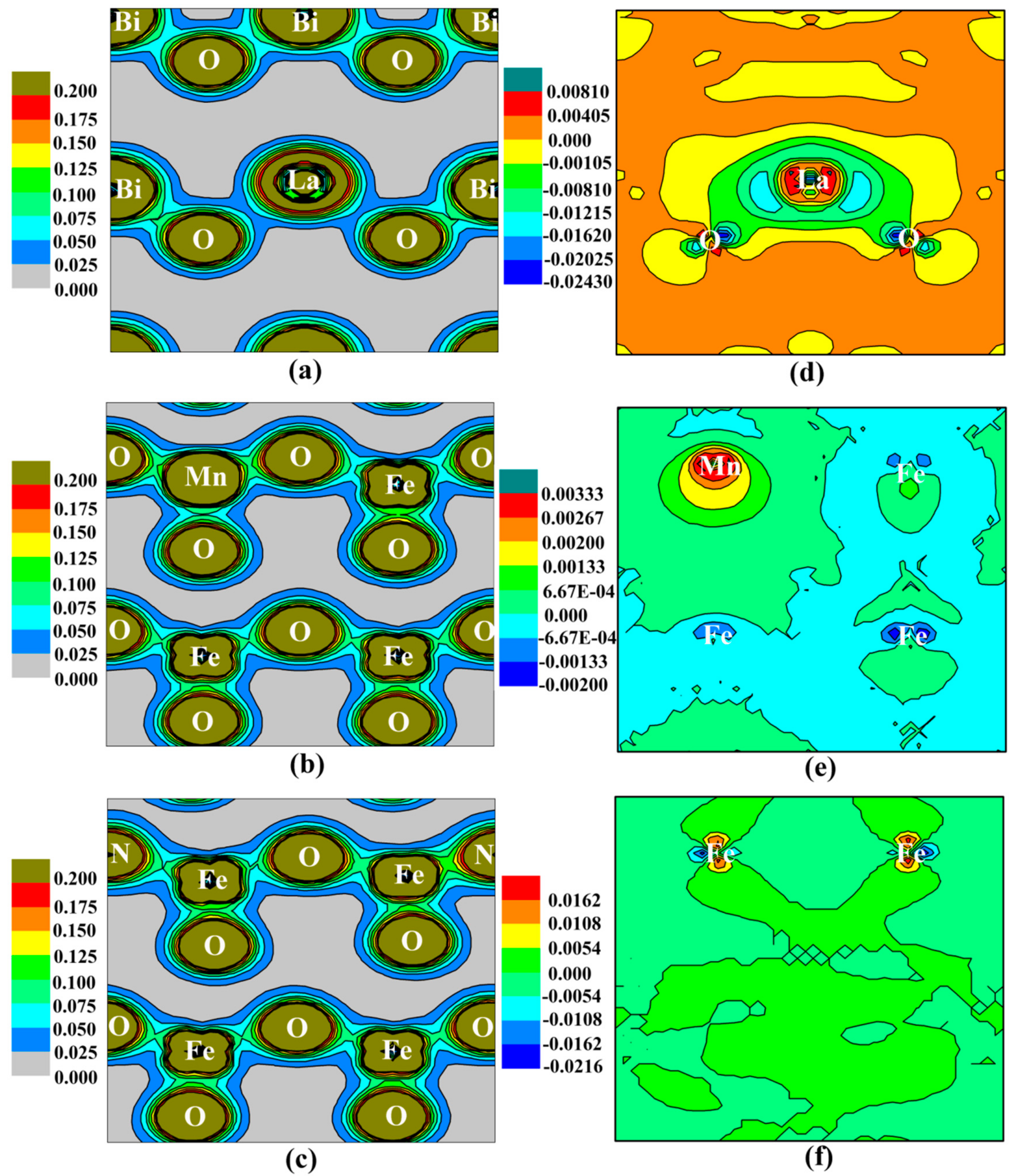Magnetic Properties and Spontaneous Polarization of La-, Mn- and N-Doped Tetragonal BiFeO3: A First-Principles Study
Abstract
:1. Introduction
2. Computational Details
3. Results and Discussion
4. Conclusions
Author Contributions
Funding
Conflicts of Interest
References
- Ramesh, R.; Spaldin, N.A. Multiferroics: Progress and prospects in thin films. Nat. Mater. 2007, 6, 21–29. [Google Scholar] [CrossRef] [PubMed]
- Catalan, G.; Scott, J.F. Physics and applications of bismuth ferrite. Adv. Mater. 2009, 21, 2463–2485. [Google Scholar] [CrossRef]
- Li, P.; Lin, Y.H.; Nan, C.W. Effect of nonmagnetic alkaline-earth dopants on magnetic properties of BiFeO3 thin films. J. Appl. Phys. 2011, 110, 033922. [Google Scholar] [CrossRef]
- Zhang, Z.; Wu, P.; Chen, L.; Wang, J.L. Systematic variations in structural and electronic properties ofBiFeO3by A-site substitution. Appl. Phys. Lett. 2010, 96, 012905. [Google Scholar] [CrossRef]
- Khomchenko, V.A.; Kiselev, D.A.; Bdikin, I.K.; Shvartsman, V.V.; Borisov, P.; Kleemann, W.; Vieira, J.M.; Kholkin, A.L. Crystal structure and multiferroic properties of Gd-substituted BiFeO3. Appl. Phys. Lett. 2008, 93, 262905. [Google Scholar] [CrossRef]
- Jeon, N.; Rout, D.; Kim, W., III; Kang, S.-J.L. Enhanced multiferroic properties of single-phaseBiFeO3bulk ceramics by Ho doping. Appl. Phys. Lett. 2011, 98, 072901. [Google Scholar] [CrossRef]
- Yu, B.F.; Li, M.Y.; Hu, Z.Q.; Pei, L.; Guo, D.Y.; Zhao, X.Z.; Dong, S.X. Enhanced multiferroicproperties of the high-valence Pr doped BiFeO3thin film. Appl. Phys. Lett. 2008, 93, 182909. [Google Scholar] [CrossRef]
- Lee, Y.H.; Wu, J.M.; Lai, C.H. Influence of La doping in multiferroic properties of BiFeO3thinfilms. Appl. Phys. Lett. 2006, 88, 042903. [Google Scholar] [CrossRef]
- Yoneda, Y.; Kitanaka, Y.; Noguchi, Y.; Miyayama, M. Electronic and local structures of Mn-doped BiFeO3 crystals. Phys. Rev. B 2012, 86, 184112. [Google Scholar] [CrossRef]
- Zhang, Q.; Kim, C.H.; Jang, Y.H.; Hwang, H.J.; Cho, J.H. Multiferroic properties and surfacepotential behaviors in cobalt-doped BiFeO3film. Appl. Phys. Lett. 2010, 96, 152901. [Google Scholar] [CrossRef]
- Yan, F.; Lai, M.O.; Lu, L.; Zhu, T.J. Enhanced multiferroic properties and valence effect of Ru-doped BiFeO3thin films. J. Phys. Chem. C 2010, 114, 6994–6998. [Google Scholar] [CrossRef]
- Wei, J.; Haumont, R.; Jarrier, R.; Berhtet, P.; Dkhil, B. Nonmagnetic Fe-site doping of BiFeO3multiferroic ceramics. Appl. Phys. Lett. 2010, 96, 102509. [Google Scholar] [CrossRef]
- Chang, F.G.; Zhang, N.; Yang, F.; Wang, S.X.; Song, G.L. Effect of Cr substitution on the structure and electrical properties of BiFeO3 ceramics. J. Phys. D Appl. Phys. 2007, 40, 7799–7803. [Google Scholar] [CrossRef]
- Xu, Q.Y.; Zai, H.F.; Wu, D.; Qiu, T.; Xu, M.X. The magnetic properties of Bi (Fe0.95Co0.05)O3ceramics. Appl. Phys. Lett. 2009, 95, 112510. [Google Scholar] [CrossRef]
- Hong, N.H.; Huong, N.T.; Kim, T.Y.; Goumri-Said, S.; Kanoun, M.B. Tuning magnetic properties ofBiFeO3thin films by controlling rare-earth doping: Experimental and first-principles studies. J. Phys. Chem. C 2015, 119, 14351–14357. [Google Scholar]
- Kim, K.E.; Jang, B.K.; Heo, Y.; Lee, J.H.; Jeong, M.; Lee, J.Y.; Seidel, J.; Yang, C.H. Electric control of straight stripe conductive mixed-phase nanostructures in La-doped BiFeO3. NPG Asia Mater. 2014, 6, e81. [Google Scholar] [CrossRef]
- Cheng, Z.X.; Li, A.H.; Wang, X.L.; Dou, S.X.; Ozawa, K.; Kimura, H.; Zhang, S.J.; Shrout, T.R. Structure, ferroelectric properties, and magnetic properties of the La-doped bismuth ferrite. J. Appl. Phys. 2008, 103, 07E507. [Google Scholar] [CrossRef] [Green Version]
- Kim, W.H.; Son, J.Y. The effects of La substitution on ferroelectric domain structure andmultiferroic properties of epitaxially grown BiFeO3thin films. Appl. Phys. Lett. 2013, 103, 132907. [Google Scholar] [CrossRef]
- Rangi, M.; Sanghi, S.; Jangra, S.; Kaswan, K.; Khasa, S.; Agarwal, A. Crystal structure transformation and improved dielectric and magnetic properties of La-substituted BiFeO3multiferroics. Ceram. Int. 2017, 43, 12095. [Google Scholar] [CrossRef]
- You, L.; Caesario, P.; Fang, L.; Ren, P.; Wang, L.; Zhou, Y.; Gruverman, A.; Wang, J.L. Effect oflanthanum doping on tetragonal-like BiFeO3with mixed-phase domain structures. Phys. Rev. B 2014, 90, 134110. [Google Scholar] [CrossRef]
- Lazenka, V.V.; Ravinski, A.F.; Makoed, I.I.; Vanacken, J.; Zhang, G.; Moshchalkov, V.V. Weakferromagnetism in La-doped BiFeO3multiferroic thin films. J. Appl. Phys. 2012, 111, 123916. [Google Scholar] [CrossRef]
- Huang, J.Z.; Wang, Y.; Lin, Y.H.; Li, M.; Nan, C.W. Effect of Mn doping on electric and magneticproperties of BiFeO3thin films by chemical solution deposition. J. Appl. Phys. 2009, 106, 063911. [Google Scholar] [CrossRef]
- Bi, L.; Taussig, A.R.; Kim, H.S.; Wang, L.; Dionne, G.F.; Bono, D.; Persson, K.; Ceder, G.; Ross, C.A. Structural, magnetic, and optical properties of BiFeO3and Bi2FeMnO6epitaxial thin films: Anexperimental and first-principles study. Phys. Rev. B 2008, 78, 104106. [Google Scholar] [CrossRef]
- Choi, E.M.; Patnaik, S.; Weal, E.; Sahonta, S.-L.; Mecklenburg, G.; Wang, H.; Bi, Z.; Xiong, J.; Blamire, M.G.; Jia, Q.X.; et al. Strong room temperature magnetism in highly resistive strained thin films ofBiFe0.5Mn0.5O3. Appl. Phys. Lett. 2011, 98, 012509. [Google Scholar] [CrossRef]
- Liu, W.L.; Tan, G.Q.; Dong, G.H.; Yan, X.; Ye, W.; Ren, H.J.; Xia, A. Structure transition and multiferroic properties of Mn-doped BiFeO3 thin films. J. Mater. Sci. Mater Electron. 2014, 25, 723–729. [Google Scholar] [CrossRef]
- Ederer, C.; Spaldin, N.A. Effect of epitaxial strain on the spontaneous polarization of thin filmferroelectrics. Phys. Rev. Lett. 2005, 95, 257601. [Google Scholar] [CrossRef] [PubMed]
- Ravindran, P.; Vidya, R.; Kjekshus, A.; Fjellvag, H.; Eriksson, O. Theoreticalinvestigation of magnetoelectric behavior in BiFeO3. Phys. Rev. B 2006, 74, 224412. [Google Scholar] [CrossRef]
- Wang, J.; Neaton, J.B.; Zheng, H.; Nagarajan, V.; Ogale, S.B.; Liu, B.; Viehland, D.; Vaithyanathan, V.; Schlom, D.G.; Waghmare, V.; et al. Epitaxial BiFeO3multiferroic thin film heterostructures. Science 2003, 299, 1719–1722. [Google Scholar] [CrossRef] [PubMed]
- Béa, H.; Dupé, B.; Fusil, S.; Mattana, R.; Jacquet, E.; Warot-Fonrose, B.; Wilhelm, F.; Rogalev, A.; Petit, S.; Cros, V.; et al. Evidence for room-temperature multiferroicity in a compound with a giant axial ratio. Phys. Rev. Lett. 2009, 102, 217603. [Google Scholar] [CrossRef] [PubMed]
- Zeches, R.J.; Rossell, M.D.; Zhang, J.X.; Hatt, A.J.; He, Q.; Yang, C.-H.; Kumar, A.; Wang, C.H.; Melville, A.; Adamo, C.; et al. A strain-driven morphotropic phase boundary in BiFeO3. Science 2009, 326, 977–980. [Google Scholar] [CrossRef] [PubMed]
- Tan, X.Y.; Chen, C.L.; Jin, K.X.; Luo, B.C. Room-temperature ferromagnetism in nitrogen-doped BaTiO3. J. Alloys Compd. 2011, 509, L311–L313. [Google Scholar] [CrossRef]
- Yang, K.S.; Dai, Y.; Huang, B.B. First-principles characterization of ferromagnetism in N-dopedSrTiO3 and BaTiO3. Appl. Phys. Lett. 2012, 100, 062409. [Google Scholar] [CrossRef]
- Perdew, J.P.; Burke, K.; Ernzerhof, M. Generalized gradient approximation made simple. Phys. Rev. Lett. 1996, 77, 3865–3868. [Google Scholar] [CrossRef] [PubMed]
- Giannozzi, P.; Baroni, S.; Bonini, N.; Calandra, M.; Car, R.; Cavazzoni, C.; Ceresoli, D.; Chiarotti, G.L.; Cococcioni, M.; Dabo, I.; et al. QUANTUM ESPRESSO: A modular and open-source software project for quantum simulations of materials. J. Phys. Condens. Matter 2009, 21, 395502. [Google Scholar] [CrossRef] [PubMed]
- Constantin, L.A.; Terentjevs, A.; Sala, F.D.; Cortona, P.; Fabiano, E. Semiclassical atom theory applied to solid-state physics. Phys. Rev. B 2016, 93, 045126. [Google Scholar] [CrossRef]
- Wu, Z.G.; Cohen, R.E. More accurate generalized gradient approximation for solids. Phys. Rev. B 2006, 73, 235116. [Google Scholar] [CrossRef]
- Zhao, Y.; Truhlar, D.G. Construction of a generalized gradient approximation by restoring the density- gradient expansion and enforcing a tight Lieb–Oxford bound. Phys. Rev. B 2008, 128, 184109. [Google Scholar] [CrossRef] [PubMed]
- Perdew, J.P.; Ruzsinszky, A.; Csonka, G.; Vydrov, O.A.; Scuseria, G.E.; Constantin, L.A.; Zhou, X.L.; Burke, K. Restoring the Density-Gradient Expansion for Exchange in Solids and Surfaces. Phys. Rev. Lett. 2008, 100, 136406. [Google Scholar] [CrossRef] [PubMed]
- Gopal, P.; Spaldin, N.A. Magnetic interactions in transition-metal-doped ZnO: An ab initio study. Phys. Rev. B 2006, 74, 094418. [Google Scholar] [CrossRef]
- Cococcocioni, M.; Gironcoli, S.D. Linear response approach to the calculation of the effectiveinteraction parameters in the LDA+ U method. Phys. Rev. B 2005, 71, 035105. [Google Scholar] [CrossRef]
- Monkhorst, H.J.; Pack, J.D. Special points for Brillouin-zone integrations. Phys. Rev. B 1976, 13, 5188. [Google Scholar] [CrossRef]
- Pack, J.D.; Monkhorst, H.J. Special points for Brillouin-zone integrations. Phys. Rev. B 1977, 16, 1746. [Google Scholar] [CrossRef]
- Methfessel, M.; Paxton, A.T. High-precision sampling for Brillouin-zone integration in metals. Phys. Rev. B 1989, 40, 3616. [Google Scholar] [CrossRef]
- MacDougall, G.J.; Christen, H.M.; Siemons, W.; Biegalski, M.D.; Zarestky, J.L.; Liang, S.; Dagotto, E.; Nagler, S.E. Antiferromagnetic transitions in tetragonal-like BiFeO3. Phys. Rev. B 2012, 85, 100406. [Google Scholar] [CrossRef]
- Diéguez, O.; Gonzalez-Vazquez, O.E.; Wojdel, J.C.; Iñiguez, J. First-principles predictions of low-energy phases of multiferroic BiFeO3. Phys. Rev. B 2011, 83, 0940105. [Google Scholar] [CrossRef]
- Hatt, A.J.; Spaldin, N.A.; Ederer, C. Strain-induced isosymmetric phase transition in BiFeO3. Phys. Rev. B 2010, 81, 054109. [Google Scholar] [CrossRef]
- Paudel, T.R.; Jaswal, S.S.; Tsymbal, E.Y. Intrinsic defects in multiferroic BiFeO3and their effect onmagnetism. Phys. Rev. B 2012, 85, 104409. [Google Scholar] [CrossRef]
- Wang, Q.J.; Tan, Q.H.; Liu, Y.K. First-principles study on ferromagnetism in Mn-doped tetragonalBiFeO3. Comput. Mater. Sci. 2015, 105, 1–5. [Google Scholar] [CrossRef]
- Wu, H.; Stroppa, A.; Sakong, S.; Picozzi, S.; Scheffler, M.; Kratzer, P. Magnetism in C-or N-doped MgOand ZnO: A density-functional study of impurity pairs. Phys. Rev. Lett. 2010, 105, 267203. [Google Scholar] [CrossRef] [PubMed]
- Vanderbilt, D.; King-Smith, R.D. Electric polarization as a bulk quantity and its relation to surface charge. Phys. Rev. B 1993, 48, 4442. [Google Scholar] [CrossRef]
- Resta, R. Macroscopic polarization in crystalline dielectrics: The geometric phase approach. Rev. Mod. Phys. 1994, 66, 899. [Google Scholar] [CrossRef]
- Zhang, J.X.; He, Q.; Trassin, M.; Luo, W.; Yi, D.; Rossell, M.D.; Yu, P.; You, L.; Wang, C.H.; Kuo, C.Y.; et al. Microscopic origin of the giant ferroelectric polarization in tetragonal-like BiFeO3. Phys. Rev. Lett. 2011, 107, 147602. [Google Scholar] [CrossRef] [PubMed]
- Ricinschi, D.; Yun, K.Y.; Okuyama, M. A mechanism for the 150 µC cm−2 polarization of BiFeO3films based on first-principles calculations and new structural data. J. Phys. Condens. Matter 2006, 18, L97–L105. [Google Scholar] [CrossRef] [PubMed]
- Troyanchuk, I.O.; Karpinsky, D.V.; Bushinsky, M.V.; Khomchenko, V.A.; Kakazei, G.N.; Araujo, J.P.; Tovar, M.; Sikolenko, V.; Efimov, V.; Kholkin, A.L. Isothermal structural transitions, magnetization andlarge piezoelectric response in Bi1−xLaxFeO3perovskites. Phys. Rev. B 2011, 83, 054109. [Google Scholar] [CrossRef]
- Rusakov, D.A.; Abakumov, A.M.; Yamaura, K.; Belik, A.A.; Tendeloo, G. Van; Takayama-Muromachi, E. Structural evolution of the BiFeO3-LaFeO3 system. Chem. Mater. 2010, 23, 285–292. [Google Scholar] [CrossRef]
- González-Vázquez, O.E.; Wojdeł, J.C.; Diéguez, O.; Íñiguez, J. First-principles investigation of thestructural phases and enhanced response properties of the BiFeO3-LaFeO3multiferroicsolidsolution. Phys. Rev. B 2012, 85, 064119. [Google Scholar] [CrossRef]
- Karpinsky, D.V.; Troyanchuk, I.O.; Tovar, M.; Sikolenko, V.; Efimov, V.; Kholkin, A.L. Evolution of crystal structure and ferroic properties of La-doped BiFeO3 ceramics near the rhombohedral-orthorhombic phase boundary. J. Alloys Compd. 2013, 555, 101–107. [Google Scholar] [CrossRef]





| Configurations | dN―N (Å) | Ground State | Relative Energy (meV) | Mtot (μB) |
|---|---|---|---|---|
| (f, 1) | 3.769 | AFM | 706.5 | 0 |
| (f, 2) | 5.330 | FM | 674.5 | 2 |
| (f, 3) | 4.946 | AFM | 733.9 | 0 |
| (f, 4) | 6.218 | FM | 705.4 | 2 |
| (f, 5) | 7.271 | AFM | 704.5 | 0 |
| (s, 1) | 2.427 | - | 43.5 | 0 |
| (s, 2) | 3.769 | - | 186.8 | 0 |
| (s, 3) | 2.948 | FM | 0 | 2 |
| (3, 4) | 2.952 | FM | 354.8 | 1.99 |
| (s, 4) | 4.946 | FM | 201.5 | −1.98 |
| (s, 5) | 5.603 | FM | 91.9 | 1.97 |
| (s, 6) | 6.192 | AFM | 159.9 | 0 |
| Configurations | dN―N (Å) | Ground State | Relative Energy (meV) | Mtot (μB) |
|---|---|---|---|---|
| (f, 1) | 3.769 | AFM | 586.7 | 0 |
| (f, 2) | 5.330 | FM | 586.7 | −2 |
| (f, 3) | 4.946 | FM | 778.4 | −2 |
| (f, 4) | 6.218 | AFM | 766.7 | 0 |
| (f, 5) | 7.271 | FM | 690.1 | −2 |
| (s, 1) | 2.410 | - | 29.9 | 0 |
| (s, 2) | 3.769 | - | 211.1 | 0 |
| (s, 3) | 2.923 | FM | 0 | −2 |
| (3, 4) | 3.155 | FM | 348.4 | −1.94 |
| (s, 4) | 4.946 | AFM | 249.9 | 0 |
| (s, 5) | 5.639 | AFM | 119.3 | 0 |
| (s, 6) | 6.204 | FM | 220.3 | 1.99 |
| Compound | Spontaneous Polarization P (µC/cm2) | Energy Barrier Height (eV/f.u.) | ||
|---|---|---|---|---|
| G | C | G | C | |
| 12.5% La-doped BFO | 154.4 | 150.3 | 2.125 | 2.160 |
| 12.5% Mn-doped BFO | 145.0 | 123.8 | 2.086 | 2.080 |
| 4.17% N-doped BFO | 147.3 | 149.5 | 2.146 | 2.176 |
© 2018 by the authors. Licensee MDPI, Basel, Switzerland. This article is an open access article distributed under the terms and conditions of the Creative Commons Attribution (CC BY) license (http://creativecommons.org/licenses/by/4.0/).
Share and Cite
Tan, Q.; Wang, Q.; Liu, Y. Magnetic Properties and Spontaneous Polarization of La-, Mn- and N-Doped Tetragonal BiFeO3: A First-Principles Study. Materials 2018, 11, 985. https://doi.org/10.3390/ma11060985
Tan Q, Wang Q, Liu Y. Magnetic Properties and Spontaneous Polarization of La-, Mn- and N-Doped Tetragonal BiFeO3: A First-Principles Study. Materials. 2018; 11(6):985. https://doi.org/10.3390/ma11060985
Chicago/Turabian StyleTan, Qiuhong, Qianjin Wang, and Yingkai Liu. 2018. "Magnetic Properties and Spontaneous Polarization of La-, Mn- and N-Doped Tetragonal BiFeO3: A First-Principles Study" Materials 11, no. 6: 985. https://doi.org/10.3390/ma11060985
APA StyleTan, Q., Wang, Q., & Liu, Y. (2018). Magnetic Properties and Spontaneous Polarization of La-, Mn- and N-Doped Tetragonal BiFeO3: A First-Principles Study. Materials, 11(6), 985. https://doi.org/10.3390/ma11060985




